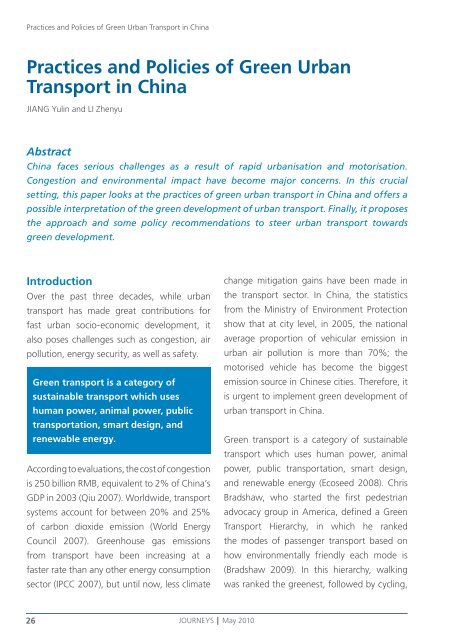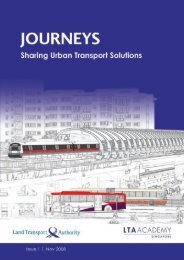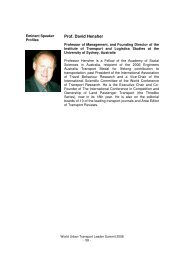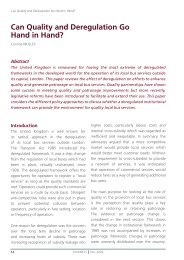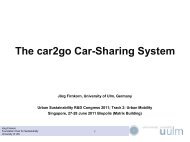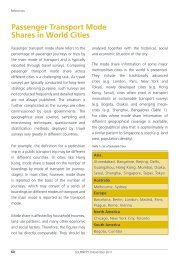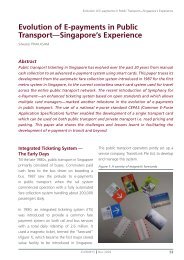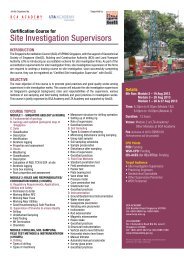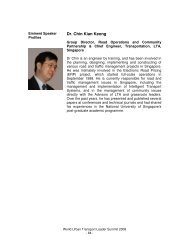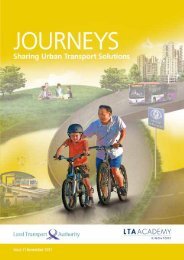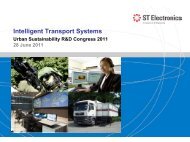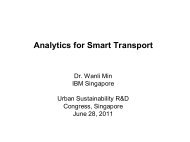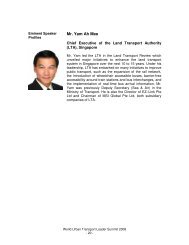Issue 4 May 2010 - LTA Academy
Issue 4 May 2010 - LTA Academy
Issue 4 May 2010 - LTA Academy
You also want an ePaper? Increase the reach of your titles
YUMPU automatically turns print PDFs into web optimized ePapers that Google loves.
Practices and Policies of Green Urban Transport in China<br />
Practices and Policies of Green Urban<br />
Transport in China<br />
JIANG Yulin and LI Zhenyu<br />
Abstract<br />
China faces serious challenges as a result of rapid urbanisation and motorisation.<br />
Congestion and environmental impact have become major concerns. In this crucial<br />
setting, this paper looks at the practices of green urban transport in China and offers a<br />
possible interpretation of the green development of urban transport. Finally, it proposes<br />
the approach and some policy recommendations to steer urban transport towards<br />
green development.<br />
Introduction<br />
Over the past three decades, while urban<br />
transport has made great contributions for<br />
fast urban socio-economic development, it<br />
also poses challenges such as congestion, air<br />
pollution, energy security, as well as safety.<br />
Green transport is a category of<br />
sustainable transport which uses<br />
human power, animal power, public<br />
transportation, smart design, and<br />
renewable energy.<br />
According to evaluations, the cost of congestion<br />
is 250 billion RMB, equivalent to 2% of China’s<br />
GDP in 2003 (Qiu 2007). Worldwide, transport<br />
systems account for between 20% and 25%<br />
of carbon dioxide emission (World Energy<br />
Council 2007). Greenhouse gas emissions<br />
from transport have been increasing at a<br />
faster rate than any other energy consumption<br />
sector (IPCC 2007), but until now, less climate<br />
26<br />
JOURNEYS <strong>May</strong> <strong>2010</strong><br />
change mitigation gains have been made in<br />
the transport sector. In China, the statistics<br />
from the Ministry of Environment Protection<br />
show that at city level, in 2005, the national<br />
average proportion of vehicular emission in<br />
urban air pollution is more than 70%; the<br />
motorised vehicle has become the biggest<br />
emission source in Chinese cities. Therefore, it<br />
is urgent to implement green development of<br />
urban transport in China.<br />
Green transport is a category of sustainable<br />
transport which uses human power, animal<br />
power, public transportation, smart design,<br />
and renewable energy (Ecoseed 2008). Chris<br />
Bradshaw, who started the first pedestrian<br />
advocacy group in America, defined a Green<br />
Transport Hierarchy, in which he ranked<br />
the modes of passenger transport based on<br />
how environmentally friendly each mode is<br />
(Bradshaw 2009). In this hierarchy, walking<br />
was ranked the greenest, followed by cycling,


